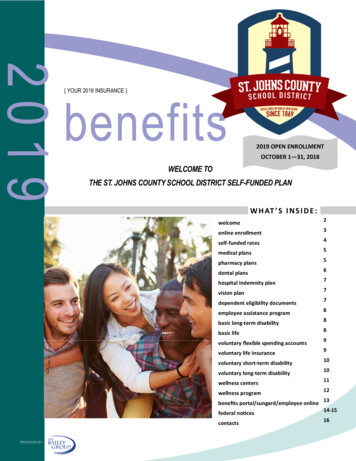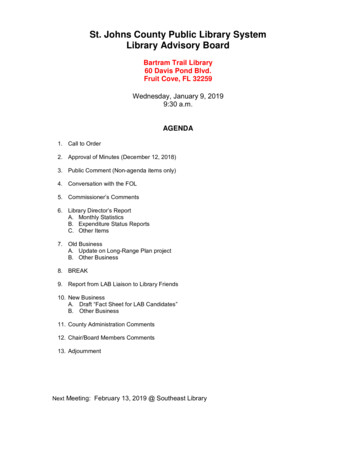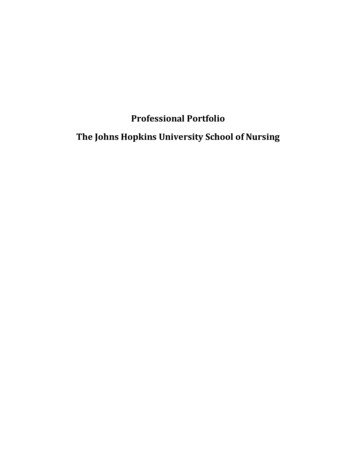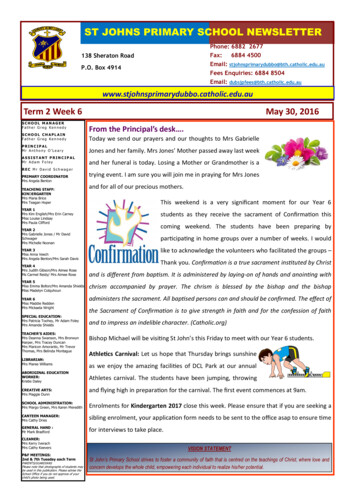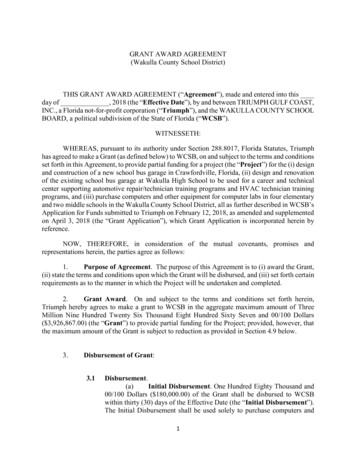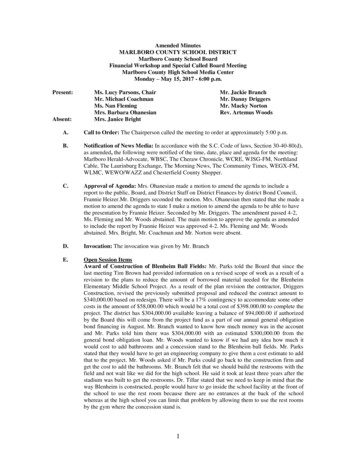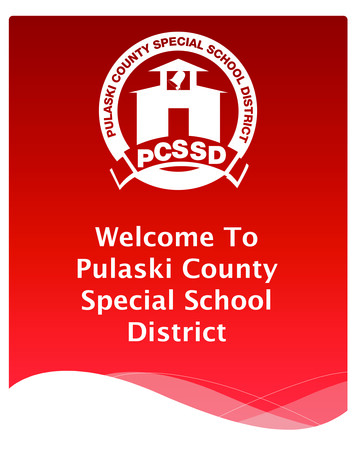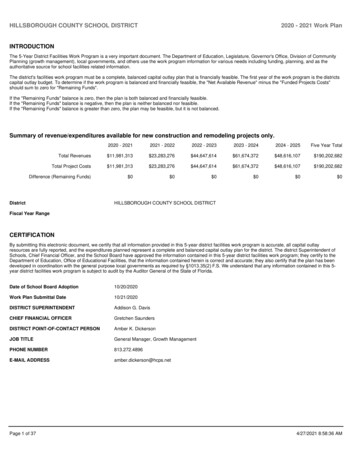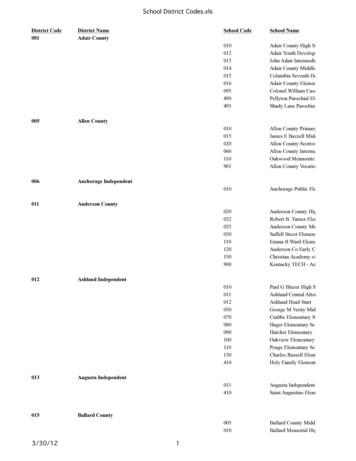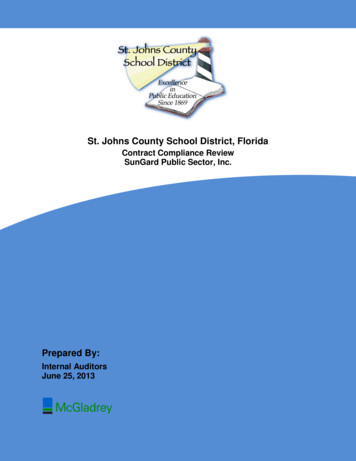
Transcription
St. Johns County School District, FloridaContract Compliance ReviewSunGard Public Sector, Inc.Prepared By:Internal AuditorsJune 25, 2013
TABLE OF CONTENTSSECTIONPAGETransmittal Letter . 1Executive Summary . 2 - 4Objectives and Approach . 5 - 6Background . 7 - 9Service Ticket Analytics . 10 - 11Survey Results . 12 - 18Issues Matrix . 19 - 21Best Practices . 22
McGladrey LLP7351 Office Park PlaceMelbourne, Florida 32940-8229O 321-751-6200 F 321-751-1385www.mcgladrey.comJune 25, 2013The School Board of St. Johns County, FloridaSt. Augustine, FL 32084Pursuant to the approved 2012 / 2013 audit plan for the St. Johns County School District (“District”), wehave conducted a Contract Compliance Review of the SunGard Public Sector, Inc. agreement. We will bepresenting this report to the Audit Committee at the next scheduled meeting on June 25, 2013.Our report includes the following:Executive SummaryThis section provides a high-level summary of the results ofour review.Objectivesand ApproachThe objectives and approach are expanded upon in thissection, which provides an outline of the various phases of ourreview.BackgroundThis section provides an overview of the SunGard contractand common definitions used throughout this report, as wellas the results of the following: Service Ticket Analytics SunGard User Satisfaction SurveyObservations andRecommendationsThis section details the observations and recommendationsidentified through our procedures.Best PracticesThis section provides a description of our processimprovement observations and recommended actions.We would like to thank the various departments for their assistance and cooperation afforded to usthroughout this engagement.Respectfully submitted,McGladrey, LLP1
Executive Summary
Executive SummaryThe primary purpose of this review was to assess St. Johns Information Technology’s (“SJIT”) compliancewith the terms and conditions of the following Agreements as they related to the implementation of thenew SunGard Information Technology System: SunGard - Software License and Services Agreement – including all amendments / addendumsSunGard - Software Maintenance AgreementThe following section provides a summary of each issue identified during our procedures as well as therelative risk rating assigned to the issue. Each issue is assigned a relative risk factor. Relative risk is anevaluation of the severity of the concern and the potential impact on operations. Items rated as “High”risk are considered to be of immediate concern and could cause significant operational issues if notaddressed. Items rated as “Moderate” risk may also cause operational issues and do not requireimmediate attention, but should be addressed as soon as possible. Items rated as “Low” risk couldescalate into operational issues, but can be addressed through the normal course of conductingbusiness.In the course of performing our Contract Compliance Review, McGladrey identified that certain servicesconsidered outside of the scope of the original School Board approved contract with SunGard wereauthorized for payment by SJIT and Purchasing Management. Issue #1 below addresses this item as itrelates to SJIT and our Contract Compliance Review. As such, we will be recommending purchasing foraudit in the proposed 2013 / 2014 audit plan. We will address this matter from a purchasing perspectiveby including SunGard purchase orders in our audit procedures around Purchasing.During the early stages of the SunGard project, approximately 75 invoices were processed and approvedby SJIT management containing the following expense reimbursements that were not in compliance withthe terms and conditions of the contract: Car Rental Rates – in excess of contractual limitationAirline Travel Reimbursement – noncompliance with contractual purchase lead timesFuel Expense Reimbursement – outside of contractual allowable areaSJIT management stated that they discovered these noncompliant expenses subsequent to the invoicesbeing processes and paid and implemented more robust review procedures. Further, SJIT managementinstructed SJIT staff to revisit all prior invoices for similar issues. The result of the second review was theissuance of 2 credit memos to SunGard (114735 and 114093) requesting a total of 7,338 in refunds.These refunds were processed and received by the District. Since this matter was addressed andresolved by SJIT management, this item is not considered an issue. However, we recommend that areview checklist be implemented at project inception to create more consistency in review and mitigatethe risk of disallowable and / or unsupported charges pursuant to the terms and conditions of the contract.2
Executive Summary - continuedThe table below provides a high-level summary of the issues identified.Issues SummaryRelativeRisk1. Out of Scope Services ApprovalDuring our review, we noted that SJIT Management authorized the expenditure of 602,783 ofwork beyond the scope of the original contract without obtaining School Board approval. Thisrepresents a lack of compliance with District Policy Chapter 7.00 subparagraph (8) which statesthat the School Board shall approve any purchase or contract of 50,000 or more.HighLack of compliance with School Board purchase policy can result in the expenditure of funds orthe execution of contracts beyond the intentions and fiscal requirements of the School Board.2. Project ManagementDuring our review, we noted that St. Johns Information Technology (SJIT) managementrestructured the pricing arrangement pertaining to the use of the Remote Project Manager andthe On-Site Half-Time Project Manager.According to the contract, SunGard was to provide billed as incurred onsite project management2 weeks a month for 15 months. Upon completion of the onsite project management hours, aremote project manager would be utilized for 6 months. The remote project manager was to bebilled as a lump sum of 20,000 for the duration of the project.ModerateSJIT management converted the 20,000 lump sum remote project management fee into 100hours of remote project management.SJIT management restructured this agreement without School Board approval as required byDistrict Policy 7.00, subparagraph (8). However, this restructuring of the utilization of the remotevs. onsite project manager did not increase the total contracted fees for these activities. Finally,management was not able to provide sufficient tracking documentation reflecting that theconverted 100 hours were exhausted.Best PracticesDuring the course of our review, we identified various opportunities for process improvement. The followingsection provides a summary of each item identified.Best PracticesLicense and Maintenance for Unused Modules – We recommend that SJIT management conduct anassessment and formally document whether or not these modules will be utilized, as well as the cost vsbenefit of retaining active licenses and maintenance contracts for the unused modules.This assessment will provide transparency for the School Board or other interested party to properly trackand monitor these matters.Reimbursable Mileage Expenses – We recommend the District include language in future contractsrequiring mileage verification from the vendor to be submitted as evidence for reimbursement. For example:an attached PDF map clearly defining the distances travelled, signed by the vendor, would qualify assufficient documentation.We also recommend the District implement a mileage cap or not-to-exceed per occurrence limit to furthermitigate exposure in this reimbursement area.Milestone Dates - We recommend that for future projects, the District implement a policy requiringattendance and active participation in training sessions by all process owners affected by a new system orproposed system modifications.3
Executive Summary - continuedIn addition to compliance testing of the agreements noted above, McGladrey conducted analytical procedures onIT Service Tickets, compilation and analysis of a SunGard User Survey distributed to users system wide, andidentification of best practices to be considered for implementation on current / future projects.IT Service Ticket ResultsDuring our review, we obtained both the SunGard and the SJIT Technical Assistance / Service Ticket Logs andperformed analytical procedures in regards to the number of tickets for the duration of the implementation. Theobjective was to obtain an understanding of how frequently both SunGard and SJIT support services were beingutilized throughout the course of the implementation.Consistent with our expectations derived from experience, inquiry and observation; service ticket numbers forboth SunGard and SJIT decreased as the District’s comfort level with SunGard increased. The natural decline ofservice ticket volume over the course of the implementation indicates effective incorporation of the new systeminto District procedures.SunGard Survey ResultsDuring our review, we prepared and circulated a SunGard User survey to 120 St. Johns County School Districtpersonnel and school secretaries identified as regular users of the new information technology system. Theresponse rate for the survey was approximately 66% with 80 users providing feedback. Survey participantsincluded 41 school secretaries and 79 District employees from various departments including: Human ResourcesFacilitiesAcademic ServicesOffice of the Chief Financial OfficerInformation TechnologyThe results of our survey revealed there is a majority consensus among the survey participants that SunGard isan improvement over the previous Oracle system that it has replaced. 83% of respondents feel the SunGardsystem provides the school district with a more controlled and secure transaction environment. The detailedresults of the customer satisfaction surveys can be found in the Background section of our report below.4
Objectives and Approach
Objectives and ApproachContract compliance audits are an important part of an internal audit plan, which assist in satisfying the need toappropriately manage risk for entities. The District has taken on a significant system implementation withSunGard. The contract is financially material with Information Technology complexities. It has impacted theDistrict significantly in all areas including Timekeeping, Human Resources, State Reporting, Accounting andBudgeting. Internal audit plans often include audits of contracts and is part of the due diligence with monitoringsignificant contracts such as this. These audits act as an important tool to assist in determining whether thecontractor is executing the terms of the agreement and delivering goods and services to the customer in theappropriate manner and at the agreed net cost.Objectives Assess contractor compliance with the terms and conditions of the following agreements: SunGard - Software License and Services Agreement (and Amendments) SunGard – Software Maintenance Agreement Validate that District policies and procedures are effective and in place for the items sampled. Identify new policies or propose modifications to existing policies that may increase the efficiency andeffectiveness of the District’s processes around the items sampled.ApproachOur approach consisted of the following phases:Phase One –Project Planning and Scoping Met with St. Johns Information Technology to obtain an understanding of the contract and to further tailorthe scope and objectives Performed a review of the SunGard Software License and Services Agreement (and Amendments) andthe SunGard Software Maintenance Agreement to gain an understanding of terms and conditions Conducted interviews with key personnel to obtain an understanding of the SunGard implementationstructure Developed work plan, task assignments and budget by task Established communication protocols, including engagement logistics and information requests. Conducted a Facilitative session with senior management and key processPhase Two – Field WorkStep 1 - SunGard Invoice Compliance Testing Interviewed key functional personnel involved in the SunGard Invoice Process Developed a Process Flow for the SunGard invoice procedural processes including the receiving,review, approval, record keeping, and payment of SunGard Invoices Obtained population of all payments to SunGard Performed reconciliation of payments, to purchase orders, to contracts Performed detailed testing of SunGard invoices for compliance with the terms and conditions ofthe contract.5
Objectives and Approach - continuedPhase Two – Field Work - continuedStep 2 – Service Ticket Analytics Obtained St. Johns to SunGard - Closed Service Tickets for FY 2010 – 2013 Obtained District User to St. Johns Information Technology - Closed Service Tickets for FY 2010– 2013 Performed ticket frequency analytics on the data obtainedStep 3 – St. John School District SunGard User SurveyDeveloped and circulated a survey to SunGard users for qualitative attributes comparison, for example: Module Utilization Overall Satisfaction Comparison to Previous System System Functionality System Issues/Resolutions Timeliness of Service HelpCompiled and summarized results of the survey and highlighted areas for improvementPhase Three - ReportingWe have summarized the results of our procedures into this report and conducted an exit conference with keyDistrict Management to discuss the details of this report. The final report represents a comprehensive overview ofthe work performed throughout the project. It provides a description of our scope and approach, as well as aprioritized list of items that require management’s attention.Major work steps: Drafted report and develop recommendations. Met with key Information Technology personnel to discuss findings. Conducted exit conference with key District Management Presented Report to the School BoardKey deliverables: Final report that highlights the findings and provides recommendations for improvement.6
Background
BackgroundRoles and ResponsibilitiesThe following departments played key roles in the process of executing the SunGard contracts:St. Johns Information Technology (SJIT)The St. Johns County School District Information and Technology Department, headed by Chief Officer BrucePatrou, retained primary responsibility for the execution of the contract including processing of invoices andmonitoring of implementation. Pages 8 and 9 provide additional background information by outlining thedepartmental structure and invoice process.PurchasingThe Purchasing department assists SJIT with system implementation by tracking purchase order usage.Common DefinitionsSome common definitions for construction terminology used throughout this report are as follows:1.District – refers to the St. Johns County School District. Where we specifically want to refer to the Board ora specific department within the District, such as Information Technology, we use the specific name.2.SunGard – refers to SunGard Public Sector, Inc., the vendor engaged in the execution of the contractslisted on the following page.3.Users – refers to St. Johns employees that are using or will use the new SunGard software.4.Implementation – refers to the process of obtaining, installing and testing the new information technologysystem encompassed in the SunGard project.5.Service Ticket – refers to the document created by system users or SJIT used to identify and summarizeproblems or issues encountered with the new system.6.Specified Enhancements – refers to improvements to the baseline software identified in the contractdocuments.7.Out of scope invoices – payments identified by the Information Technology Department as beyond thescope of the contracts listed in the chart below. The nature of these charges range from additional systemenhancements to training sessions and assistance. Out of scope invoices were billed based on the laborrates, terms and conditions of the original contracts.8.Project Manager – the individual employed by SunGard, identified to conduct various project managementresponsibilities in execution of the contracts.Project SummaryThe St. Johns County School District executed multiple agreements with SunGard Public Sector, Inc. for theimplementation, licensing, maintenance and support of a new information technology system; the details of whichwere broken out into various component units, timeframes and pricing structures. This system included multiplecomponent systems including but not limited to: Financial ApplicationsPayroll ApplicationsHuman Resources ApplicationsOther Tools7
Background - continued8
Background - continued9
Background - continuedService Ticket AnalyticsSunGard Service TicketsClosed Service TicketsDuring our review, McGladrey obtained the SunGard Technical Assistance / Service Ticket Log and performedanalytical procedures in regards to the number of tickets over the life of the implementation. The objective ofthese procedures was to provide the engagement team with an understanding of how frequently SunGardtechnical support was utilized and if that utilization falls in line with the expectations developed during onsiteinterviews and detailed invoice testing. Based on discussions with Information Technology departmentmanagement and process owners, as well as our experience, our expectation is that over the course of theimplementation, the number of service tickets will decrease. For the purposes of these procedures only closedtickets initiated after the “Go-Live” date have been included in the results summarized in the graph below. Thequarterly breakdown of these tickets is as follows:Closed Service Ticket Totals1008060Tickets4020-FY 11 Q1FY 11 Q2FY 11 Q3FY 11 Q4FY 12 Q1FY 12 Q2Closed Service Ticket Quarterly DisaggregationClosed TicketsFY 11 Q1FY 11 Q2FY 11 Q3FY 11 Q4FY 12 Q1FY 12 Q2846488696342As indicated in the results graph above, the number of service tickets has gradually declined since inception. Thisis attributable to the District’s increased comfort level with SunGard and the nature of service tickets becomingless complex. The results of these analytics are consistent with the expectations derived from our experience,inquiries and observations.10
Background - continuedService Ticket Analytics - continuedSt. John’s County School District User Service TicketsClosed Service TicketsDuring our review, McGladrey obtained the St. John’s Information Technology Department Technical Assistance /Service Ticket Log and performed analytical procedures in regards to the number of tickets over the life of theimplementation. The objective of these procedures was to provide the engagement team with an understanding ofhow frequently St. John’s technical support was utilized and if that utilization falls in line with the expectationsdeveloped during onsite interviews and detailed invoice testing. Based on discussions with SJIT management andprocess owners, as well as our experience, our expecta
Obtained St. Johns to SunGard - Closed Service Tickets for FY 2010 – 2013 Obtained District User to St. Johns Information Technology - Closed Service Tickets for FY 2010 – 2013 Performed ticket frequency analytics on the data obtai
